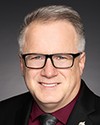Thank you, Mr. Chair.
Thank you for inviting me to appear before the Committee today.
I appreciate this opportunity to describe how Health Canada has been meeting the requirements of the Official Languages Act as we keep Canadians informed as we fight the COVID‑19 pandemic.
My name is Pamela Aung‑Thin and, as you mentioned, I am the acting assistant deputy minister of the communications and public affairs branch, which provides services to both Health Canada and the Public Health Agency of Canada.
Accompanying me today is Manon Bombardier, acting associate assistant deputy minister of Health Canada's health products and food branch.
Our branches play an important part in the government's overall response to the COVID‑19 outbreak in Canada.
I want to begin by saying that communicating with Canadians in the official language of their choice is more than just a legal or policy requirement for us—it is a core communications practice.
During a crisis, clear, effective communication takes on even greater importance because being misunderstood can put the health and safety of Canadians at risk. We take this responsibility seriously and it shapes how we do business every day.
The expectations regarding the use of official languages in government communications are quite clear. Under the Official Languages Act, federal institutions are required to communicate and offer services to the public in both official languages.
The Government of Canada's policy on communications and federal identity provides further guidance. It requires that government departments provide information in both official languages in accordance with the act, and that they consider the needs of official language minority communities in Canada in their communications.
We, in the health portfolio, strive to meet these requirements in all our communications. For example, every news release, statement or written product we issue is released in both English and French at the same time. Information published on our website is also posted simultaneously in both English and French.
During the pandemic, we are also making key information about COVID‑19 and the government's efforts to reduce the spread of the disease available in many other languages, including several indigenous languages.
When we host media availabilities and technical briefings, there are always experts available from Health Canada and the Public Health Agency of Canada to speak in both official languages.
Finally, within the department and the agency, communication with employees takes place in both official languages and employees are encouraged to work in the language of their choice.
Employees and managers are assessed at mid-year and year-end on performance objectives related to language requirements in their performance agreement.
These are standard communication practices in the Government of Canada—practices that we endeavour to follow at all times. The COVID‑19 pandemic has not changed this. While this unprecedented crisis has presented some additional challenges, we always respect official languages.
Our top priority is protecting the health and safety of Canadians. Since the beginning of the pandemic that has meant doing everything possible to control the spread of COVID‑19. This includes facilitating access to products needed to slow the spread of the disease.
With the onset of the pandemic in March 2020, there was unprecedented demand for products to limit the spread of COVID‑19, including hand sanitizers and disinfectants, household and workplace cleaners, and hand and body soaps. For these products, labels are a key source of information for Canadians about how to use these products. Normally, every product sold in Canada requires a bilingual label.
At the beginning of the pandemic, demand had increased exponentially, to the point where it was often very difficult to find many of these products on store shelves or through online retailers.
Foreign suppliers of hand sanitizers and hard surface disinfectants indicated that they were producing these products with a global English-only label, and that they would ship only to countries accepting English-only labelling.
Due to the unprecedented demand, and to ensure that Canadians would continue to have access to these products to prevent the spread of COVID‑19, Health Canada implemented interim policies in March and April 2020 to facilitate access, on a temporary and emergency basis, to certain products labelled in only one official language. To note, hand sanitizers manufactured in Canada with unilingual labels could only be sold in unilingual regions, based on the language of that region.
Health Canada closely monitored the supply of hand sanitizers and disinfectants. As supply began to stabilize, a return to bilingual labelling was proactively initiated on May 9, 2020, with a transition period permitted until June 8, 2020 for existing products. Health Canada required importers to provide information at the point of sale directing consumers to bilingual label information online.
Our interim measures helped address the high demand for health products necessary to help slow the spread of COVID‑19.
In addition, the interim measures for products manufactured in Canada supported the tremendous mobilization of the Canadian business community to support the fight against COVID‑19. All across the country, we witnessed remarkable collaboration from companies and industries that stepped up and offered their support, expertise, and resources to address critical supply needs.
To conclude, the COVID‑19 pandemic has changed so much for Canadians over the past year. However, it has not changed the health portfolio's commitment to communicating and serving Canadians in the official language of their choice.
Despite the exceptional circumstances, I am confident that the health portfolio has continued to meet its obligations under the Official Languages Act throughout this prolonged crisis.
We are now happy to answer any questions you may have.











